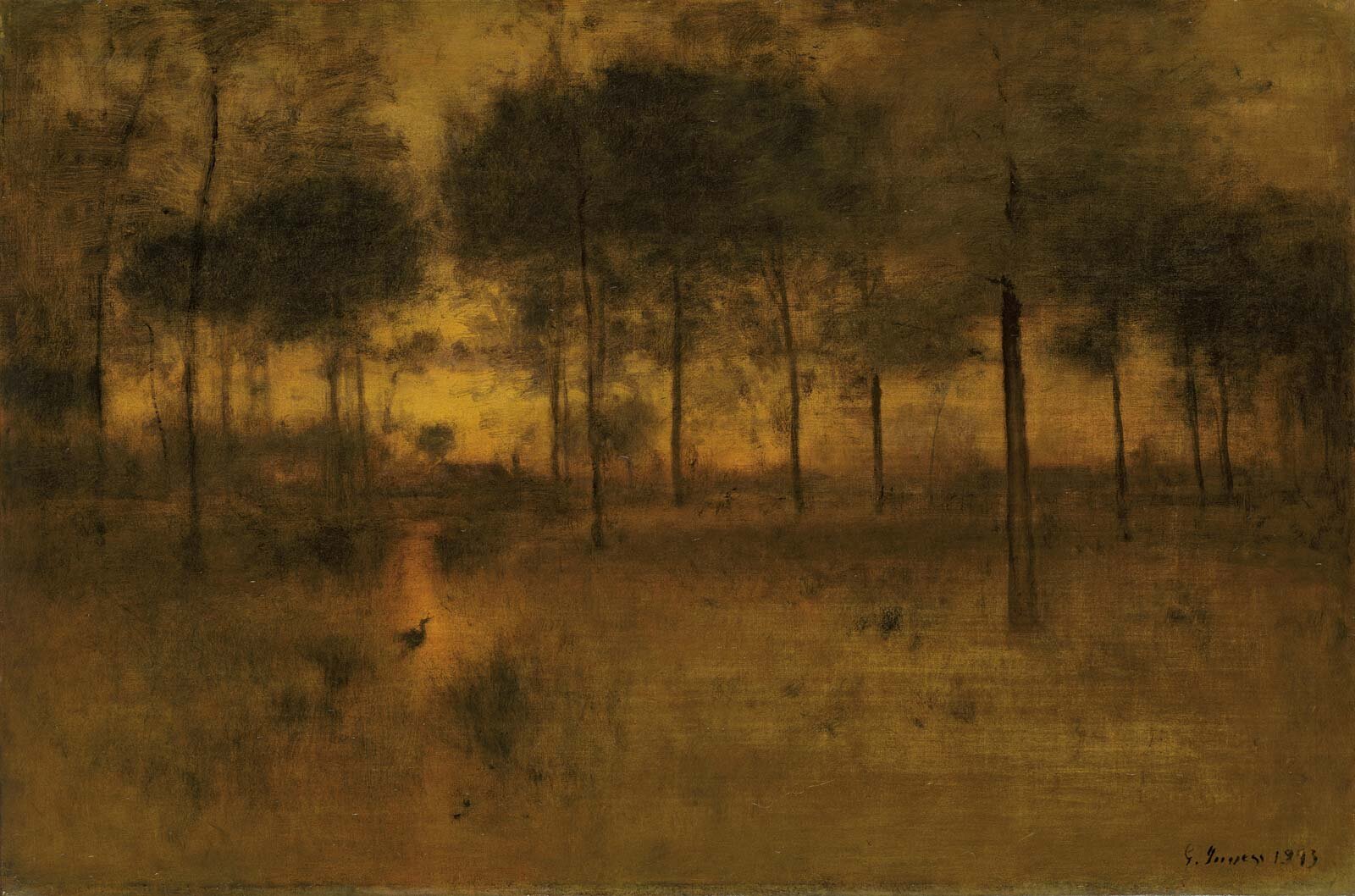What is Tonalism?
“The term tonality is used so glibly by so many writers and lecturers on art topics that it is to be feared the general art public is not always entirely certain of its meaning….tone in the simplest sense means that harmonious adjustment and blending of values and colour which gives sentiment, richness and artistic value to a picture.”
By Christopher Volpe
Art historians use the term Tonalism to describe an American artistic movement spanning from about 1880 to approximately 1920. More generally, the term (tonalism, tonalist, or tonalistic, with a lower case “t”) describes a style of painting in which color range is limited so that subtle gradations of the middle values (aka color “tones”) constitute the primary aesthetic and means of expression.
In the Barbizon Style, John Constable, Tramonto sulla Senna
Historical Tonalism, rooted in the French Barbizon style, emphasized mood, feeling, evocation and suggestion; it seemed to its early practitioners closely related to musical composition (c.f. George MacNeil Whistler’s titles referencing musical terms) and poetry (George Inness originally included poems with his paintings, to the bafflement of critics).
While the historical roots of tonalism lie mostly with nineteenth-century American painters, tonalism’s branches extend across multiple time periods and geographies. Many twentieth-century artists worked in some measure under the influence of its aesthetic principles. Artists as diverse as Yves Klein, Mark Rothko, Ad Reinhardt and Wolf Kahn have all been said to have painted to an extent in a tonalist mode; their works are united by a restricted (if not monochrome) palette, subtle modulations of closely related values, and a deeply conceptual and/or emotional/psychological (what used to be called “poetic”) approach.
Nocturne in grey and silver, 1873, James Whistler
Yet, throughout the decades of the twentieth century, the actual works of the historical Tonalists remained largely out of view. Scores of expressive landscapes by the likes of Homer Dodge Martin, Bruce Crane, Dwight Tryon, and J. Francis Murphy languished in obscure texts and museum storage rooms (many are presumably still there), with some institutions deaccessioning their work along with that of their predecessors, the nineteenth-century Hudson River School painters.
Although general interest in the Hudson River painters revived from about 1980, it took David A. Cleveland’s landmark 2010 study of the period (A History of American Tonalism: 1880-1929, Hudson Hills Press, Manchester, Vermont) to spur a widespread revival of interest (primarily among working artists) in traditional Tonalism; much of the material in this brief survey leans on that definitive work. Although some painters have never stopped working in some mode of tonalism, today there’s renewed interest in the period and the philosophy of painting behind it, and numerous artists could be said to take a “tonalistic” approach to a splendid variety of work.
Where Did Tonalism Come From?
Home of the Heron, George Inness, 1893, Chicago Institute of Art
The approach to landscape painting that would be known as Tonalism arose from a fusion between late nineteenth-century American and mid-nineteenth-century French landscape painting. Starting in the 1880s, a new generation of post-Civil War American landscape painters, inspired by the hints and innovations of a few older-guard pioneers (e.g. William Morris Hunt, George Inness), made the trip by steamer to France. There they took inspiration from the exciting developments in avant-garde landscape painting that had begun around 1830 with the painters of the Barbizon School.
The Barbizon painters (so named for the rural town, well outside Paris, where they set up shop) rejected the contrived artificiality and stuffiness of the “official” painting of the Paris Salon and took their easels out into the country to paint the total opposite: real life at its most honest and unassuming. The first true plein air painters, they dumped the French Academic trappings of Biblical stories, political propaganda and soft-porn mythological goddesses, satyrs, and nymphs. Instead they just painted the beauty – and the intensity – that they saw in the country: the gnarled trees, wet rocks, rippling waters, and simple rural communities alive in the Forest of Fontainebleau.
Unknown Artist, circa 1900.
To American artists-in-exile, this radical new theory of painting offered a more authentic, modest, and intimate approach than the grand, stylized Hollywood blockbusters of Bierstadt, Church, and the rest of the Hudson River School – for which the public was rapidly losing its taste after the rude awakenings of the Civil War (c. 1870). By the 1880s, and for the next 30 or 40 years, the spirited, intimate Tonalist landscape had fully established an entirely new chapter of American art.
Emil Carlsen, Night, Old Windham, 1904.
Low-toned, softly edged atmospheric landscape painting resonated with the transcendentalist literature of Henry David Thoreau and Ralph Waldo Emerson. They also related to the visionary, otherworldly canvases of American originals Ralph Albert Blakelock and Albert Pinkham Ryder, the latter of which taught landscape painters that “art does not render visible but makes visible.”
“In terms of Tonalist subject matter and vision, the landscapes of the pathbreaking indigenous artists Ralph Blakelock and Albert Pinkham Ryder were crucial in the development of a distinctly romantic, if not a spiritual or quasi-religious element,” as Cleveland succinctly puts it. “Mystery, dream, memory, and imagination are often espoused in their haunting, broadly painted canvases of dusk and moonlight.” It’s worth remembering that a young Jackson Pollock cited Ryder as “the only American master” that interested him.
Winter Sky, George Inness, Cleveland Museum of Art
Through the influence of mid-century innovators such as William Morris Hunt, John La Farge, Inness, Homer Dodge Martin, and Whistler, a new artistic movement took shape that seems to have felt to its innovators both radically new and eternally relevant. Perhaps they were not wholly mistaken, for a vital, younger generation rose to meet them and carried their flag into the twentieth century and beyond.
George Glenn Newell - Twilight [c.1905]






![George Glenn Newell - Twilight [c.1905]](https://images.squarespace-cdn.com/content/v1/5e2f317b5b3b8e5666cb6c75/1591919236114-X5YDFHTW82EEC7DESB1U/George+Glenn+Newell+-+Twilight+1905)